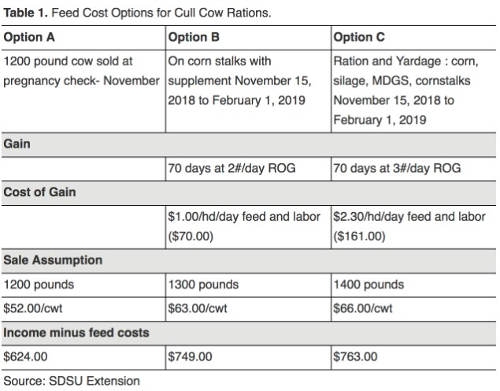With cull cow markets below average this fall, SDSU Extension Livestock Business Management Field Specialist, Heather Gessner shares resources and considerations cattle producers should review when deciding when to market cull cows.
"The 2018 slaughter cow market has been impacted by the large supply of beef in storage and an increase in cow slaughter volume compared to 2017," said Gessner, pointing to the South Dakota 2018 slaughter cow prices which are at or below 2017's average monthly prices (Figure 1).
The Livestock Marketing Information Center 2018 average through September for breaker grade cows was $65.05. "This is 4.3 percent lower than 2017," Gessner said.
If a producer plans to hold cull cows until markets improve, Gessner reminds them to pencil out what the cost of holding the culls will be so they can make the most informed decision.
"Also, not every cull cow should be held and placed on feed for a later sale date," Gessner said.
She outlined the characteristics of cows that should NOT be held. They include the following:
Cows in a body condition score (BCS) of 5 or more. Cows already in good condition, will not gain additional pounds in an efficient manner and may end up cutting into profits.
One reason to keep the cow on feed is to increase the BCS thus increasing muscle mass, the fat cover and total pounds available for sale.
Cows that are unsound or injured. These animals should be sold direct to a packer. Animals must be ambulatory and a direct sale reduces further injury. If a cow has been treated with any antibiotics ensure all withdrawal periods have been reached prior to any sales.
Cows that are unhealthy. These cows offer a whole set of management challenges to the operation. Unhealthy cows may not gain efficiently and thus may not improve the profitability of the operation through feeding. However, cows that have received medication with any antibiotics need to be monitored to ensure they are not sold before withdrawal periods are reached.
Feed cost options
Once producers accurately identify cows that have the ability to gain weight and potential to return a profit, Gessner said there are many feeding options for cull cows.
"As corn fields are harvested, grazing aftermath acres becomes one of the available options. Depending on the weather, cows may be able to graze these acres until the desired market date for limited feed cost and labor requirements," she said.
Cows can also be placed in a feedlot system and receive a balanced ration designed to maximize average daily gain and encourage the development of white fat.
"Cows placed in a feeding system will take more bunk space than other cattle, so ensure adequate bunk space is available for this option," Gessner said.
Table 1 compares three options available to producers.
If cattle producers have questions, Gessner can be contacted by email, or they can contact another member of the SDSU Extension team. A complete listing can be found at iGrow under the Field Staff icon.
 Figure 1. Monthly average price-South Dakota breaker slaughter cows.
Figure 1. Monthly average price-South Dakota breaker slaughter cows.

Table 1 compares three options available to a producer.
Source: igrow.org